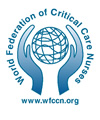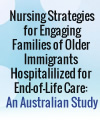Module 2: Culturally Sensitive Communication
Reflection
Defining Culturally Sensitive Communication
Australia’s population is becoming increasingly diverse, with one in four Australian’s born overseas, and nearly 20% of Australian’s speak a language other than English at home (AHRC, 2014). With an increasing number of patients from CALD backgrounds, healthcare clinicians need to remain cognisant of individual healthcare preferences (Bellamy & Gott, 2013). Culturally and linguistically diverse (CALD) refers to the range of different cultures and language groups represented in the population who identify as having cultural or linguistic affiliations by their place of birth, ancestry or ethnic origin, religion, preferred language or language spoken at home. CALD is the preferred term for Australian government and community agencies as a contemporary descriptor for ethnic communities (Department of Health, 2009).

Read the WFCCN Brisbane Declaration.

Read Nursing Strategies for Engaging Families of Older Immigrants Hospitalized for End-of-Life Care: An Australian Study.
Reflection:
Think about the last time you witnessed an end-of-life discussion with patients and families of CALD backgrounds. What was positive about the discussion? What was negative about the discussion? What style of communication was exhibited by the person conducting the discussion? What was the outcome of the discussion?
